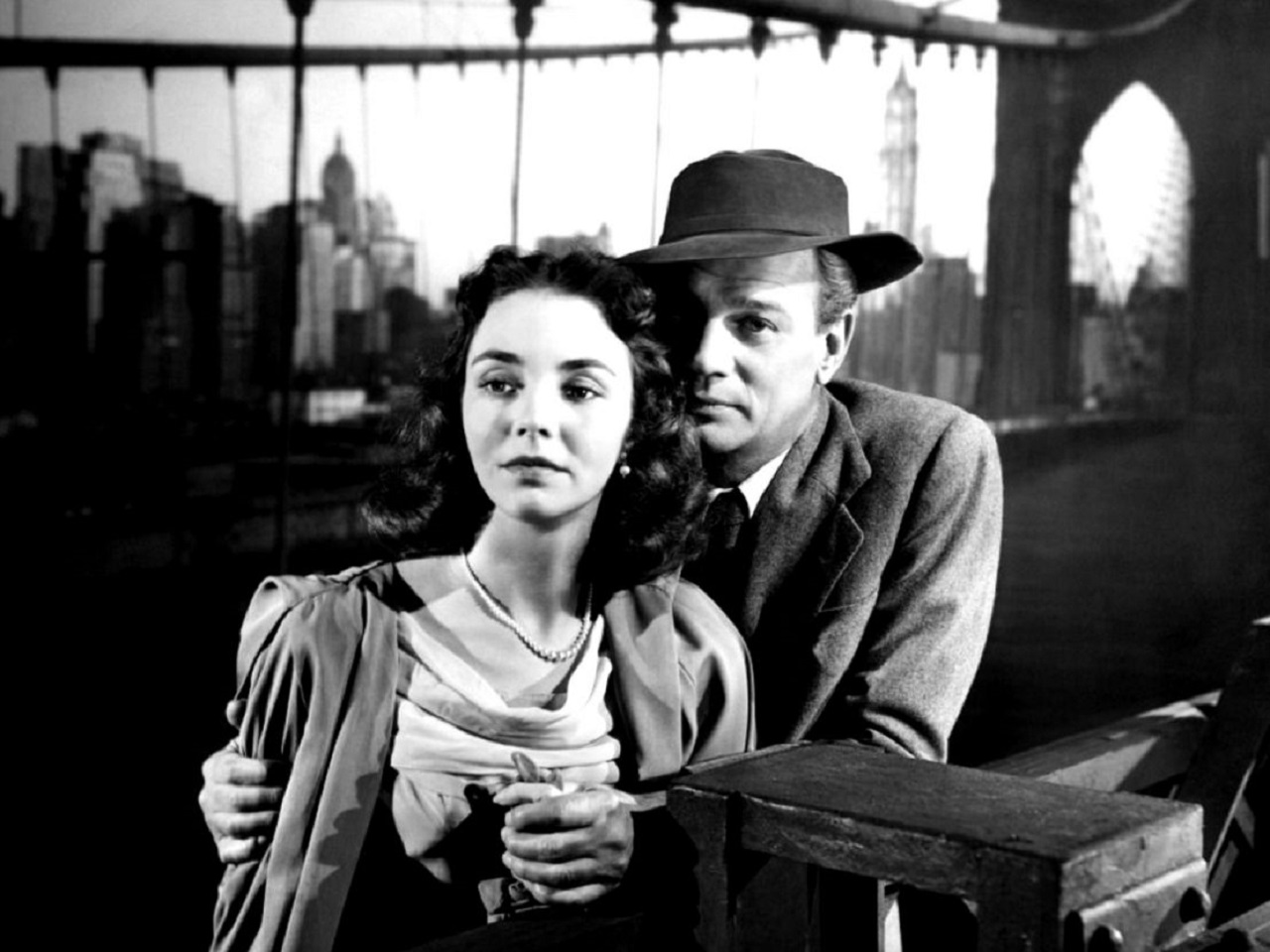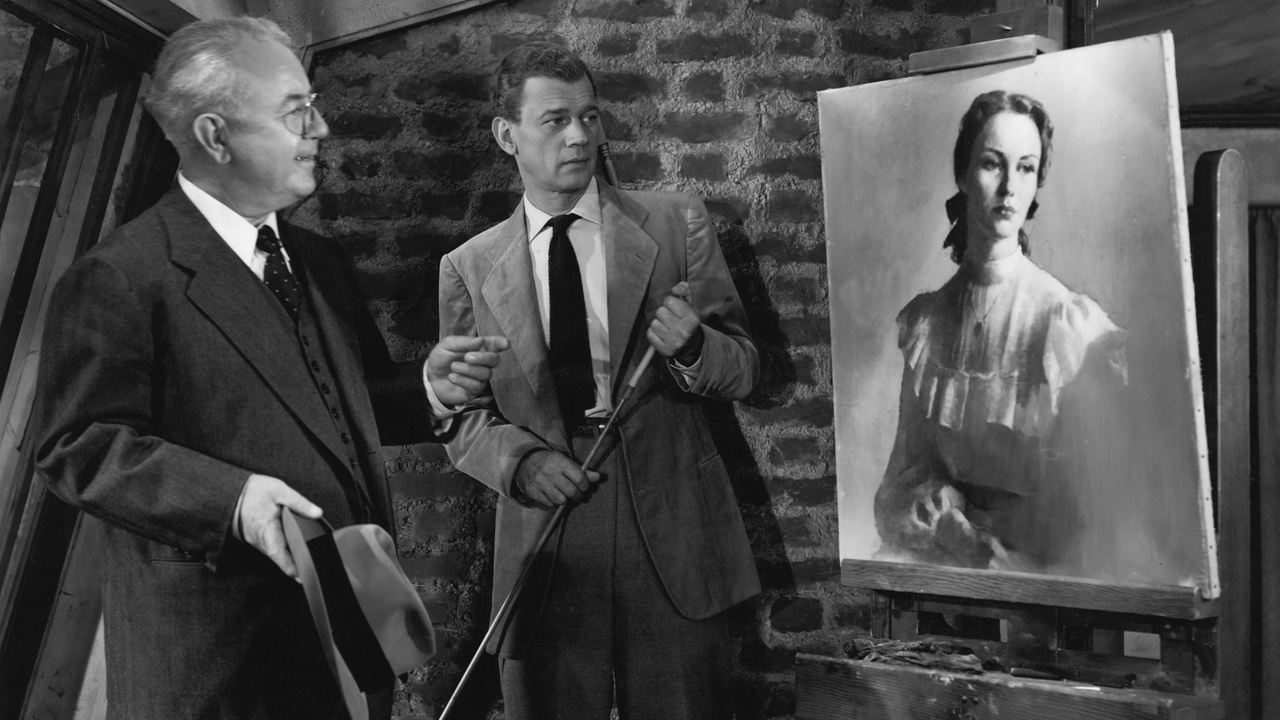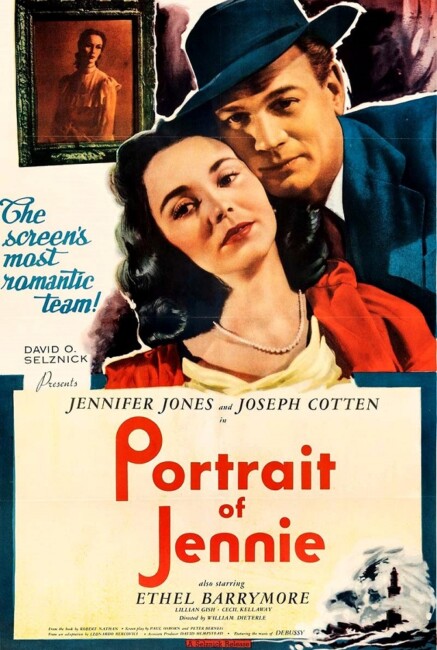Crew
Director – William Dieterle, Screenplay – Peter Bernes & Paul Osborn, Adaptation – Leonardo Bercovici, Based on the Novel Portrait of Jennie by Robert Nathan, Producer – David O. Selznick, Photography (b&w + some scenes tinted and one scene colour) – Joseph August, Music – Dimitri Tiomkin, Based on Themes from Claude Debussy, Special Effects – Claude Slifer, Production Design – J. McMillan Johnson. Production Company – Vanguard Films/The Selznick Studio.
Cast
Joseph Cotten (Eben Adams), Jennifer Jones (Jennie Appleton), Ethel Barrymore (Miss Spinney), David Wayne (Gus), Cecil Kellaway (Matthews), Lillian Gish (Mary Mother of Mercy)
Plot
In 1934, Eben Adams is a down-and-out artist in New York City. He meets a young girl Jennie Appleton in the park and is touched by her. Afterwards he is inspired to paint her portrait. The portrait marks the start of his success as an artist. Over the next few months, Jennie continues to reappear to Eben, during the course of which she mysteriously appears to advance several years in age. He also finds that the things and people that she refers to all happened many years go. The two grow deeply in love, with Eben being depressed and uninspired in his work when she is not around. Eben then learns that Jennie came to a tragic end several years ago and struggles to prevent her from meeting that.
Portrait of Jennie is a classic romantic fantasy. It comes from producer David O. Selznick who, among many other great films, had previously made Gone with the Wind (1939), as well as produced a number of Alfred Hitchcock’s films. It was made at a period during the 1940s that heralded a great vogue in afterlife fantasies – the likes of Topper (1937) and sequels, Here Comes Mr Jordan (1941), A Guy Named Joe (1943), The Ghost and Mrs Muir (1947) and other whimsies. This was the period concurrent with the aftermath of World War II where the need for reassurance in an afterlife was an overwhelming ache on the part of many who had suffered losses.
Portrait of Jennie is a classic – although not quite the classic it clearly thinks it is. It is certainly well spoken of, although has never attained the classic status that other fantasy films of the era such as The Wizard of Oz (1939), It’s a Wonderful Life (1946) and Miracle on 34th Street (1947) have. Certainly, everything is laid at the film’s disposal in a determination to make it epic and momentous. The very opening narration stretches for grand reach: “Since the beginning, man has looked into the awesome reaches of infinity and asked the eternal question – What is time? What is space? What is life? What is death?” The opening offers up quotes from both Euripedes and Keats, and announces before beginning: “Now comes our story, the truth of which lies not on our screens but in your hearts.”
Moreover, it succeeds. Without all the lavishness attached to it, Portrait of Jennie would be a fairly ordinary, maybe even quite good, weepie melodrama. Jennie’s time-travelling trick is not that well explained and other aspects like the heavy foreshadowing of her ominous feelings about the Cape Cod lighthouse painting give the game as to her tragic fate away well in advance.


It is, however, the sheer pictographic beauty that is lavished on the film that finally makes it succeed. There is a willingness upon director William Dieterle’s part to experiment with almost anything in the cinematographic arsenal and the results are quite extraordinary. At several points, the film employs a fascinating gauzed effect that makes it seem as though the film itself had become the canvas of an oil painting. During the storm climax (where the studio goes all out in the special effects department), the film moves into tinted colour – green tint for the storm, sepia for the aftermath. And in the very final scene, the film bursts into a single colour shot for a vision of the painting with breathtaking effect. There are some exquisite images – of Joseph Cotten’s face lit up, singled out amid the audience in a theatre; while, at times, the painting itself seems to give the faces looking at it a luminosity of their own.
In a period when the majority of films were shot on soundstages, including the outdoor scenes, this is one of the few films that went outside on location. There is a beautifully palpable sense of the seasons passing, which lends a magical beauty to the film. There is one exquisite shot of the ice rink surrounded by New York skyscrapers with the sun shining down making the skyscrapers and everything below it seem ephemeral. It is a moment where the film seems to almost capture something of the essence of the British painter Joseph Turner in whose work light is a transcendental luminous perfection that is real and the rest of the world seems only to have a shadowy evanescence alongside in comparison.
Director William Dieterle (1893-1972) was a German immigrant to the US. He made other genre works such as Six Hours to Live (1932), a thriller about a man resurrected from the dead; the excellent Shakespeare adaptation A Midsummer Night’s Dream (1935); the classic Charles Laughton adaptation of The Hunchback of Notre Dame (1939); the classic All That Money Can Buy/The Devil and Daniel Webster (1941) about a lawyer arguing with The Devil for a farmer’s soul; and the German-made spy thriller/mad scientist film Mistress of the World (1959).
Full film available here:-


